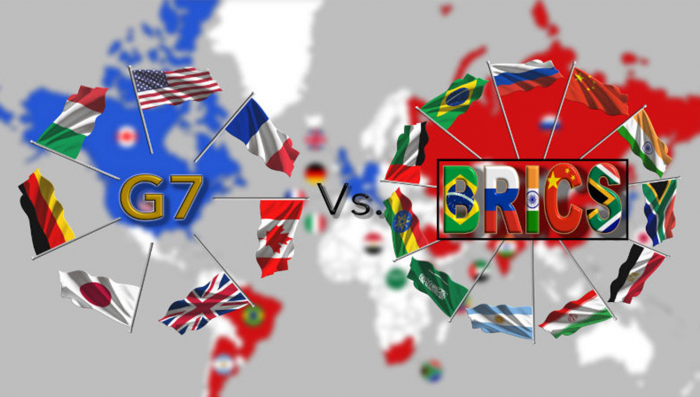Shifting Economic Balance: BRICS vis-a-vis G7
BRICS, 19 Aug 2024
Wang Wen | BRICS Portal - TRANSCEND Media Service
2 Aug 2024 – The construction of a new world order is undeniably a prolonged process. Currently, several new pillars are emerging that aim to support the establishment of this new order. In the realm of security, we see the rise of the Shanghai Cooperation Organization; politically, there is the BRICS cooperation mechanism; economically, institutions like the Asian Infrastructure Investment Bank are taking shape.
However, it is crucial to recognize that these pillars are not yet sufficient to completely overturn the existing world order and international system. Essentially, these pillars act more as supplements and reforms to the current order, rather than as revolutionary changes.
At present, initiatives such as the Belt and Road Initiative, the Eurasian Economic Union, and the Regional Comprehensive Economic Partnership (RCEP) are becoming fundamental forces promoting the emergence of a new multipolar world.
Yet, these integration associations still require significant time to develop. The unipolar world led by the West has persisted for over two hundred years. Despite a brief period of polarization during the Cold War, the current task is to further develop a series of integrated mechanisms.
The economic balance between the G7 and BRICS countries has seen a disruption. Thirty years ago, the economic output of BRICS was only one-third of that of the G7. Now, from a purchasing power parity perspective, BRICS has completely surpassed the G7.
This shift signifies significant changes in global development. Nonetheless, the G7 still holds a strong foundation, and policies aimed at containing emerging economies are likely to continue. BRICS countries must remain humble and cautious, focusing on sustainable long-term development to consistently surpass the G7 in national strength, which is crucial for their role on the global stage.
Currently, the economic prospects of emerging economies show strong potential, yet they also face substantial challenges. Domestic economic growth momentum is insufficient, and there are risks of economic spillover from developed countries.
In the short term, the urgent task for emerging economies is to promote supply-side reforms, achieve rapid economic recovery, and advance economic globalization through international multilateral cooperation. Ultimately, this will enable them to achieve medium to high-speed growth.
In conclusion, while the pillars for a new world order are forming, there is still a long way to go. The development of integrated mechanisms and the sustainable growth of emerging economies are essential for the realization of a truly multipolar world.
_________________________________________________
Wang Wen is the Executive Dean of Chongyang Institute for Financial Studies at Renmin University of China.
Go to Original – infobrics.org
Tags: BRICS, Development, Economics, Finance, G7, New World Order
DISCLAIMER: The statements, views and opinions expressed in pieces republished here are solely those of the authors and do not necessarily represent those of TMS. In accordance with title 17 U.S.C. section 107, this material is distributed without profit to those who have expressed a prior interest in receiving the included information for research and educational purposes. TMS has no affiliation whatsoever with the originator of this article nor is TMS endorsed or sponsored by the originator. “GO TO ORIGINAL” links are provided as a convenience to our readers and allow for verification of authenticity. However, as originating pages are often updated by their originating host sites, the versions posted may not match the versions our readers view when clicking the “GO TO ORIGINAL” links. This site contains copyrighted material the use of which has not always been specifically authorized by the copyright owner. We are making such material available in our efforts to advance understanding of environmental, political, human rights, economic, democracy, scientific, and social justice issues, etc. We believe this constitutes a ‘fair use’ of any such copyrighted material as provided for in section 107 of the US Copyright Law. In accordance with Title 17 U.S.C. Section 107, the material on this site is distributed without profit to those who have expressed a prior interest in receiving the included information for research and educational purposes. For more information go to: http://www.law.cornell.edu/uscode/17/107.shtml. If you wish to use copyrighted material from this site for purposes of your own that go beyond ‘fair use’, you must obtain permission from the copyright owner.
